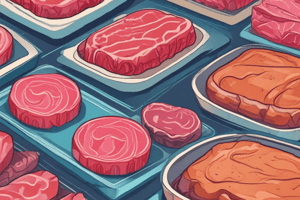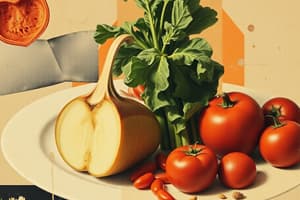Podcast
Questions and Answers
What is one key factor that influences a cook's judgment?
What is one key factor that influences a cook's judgment?
- Raw materials available (correct)
- Length of cooking time
- Popularity of the dish
- The quantity of ingredients
A written recipe is always 100% correct.
A written recipe is always 100% correct.
False (B)
What has professional cooking evolved to focus on beyond just recipes?
What has professional cooking evolved to focus on beyond just recipes?
Procedures and methods
A chef improves their skills by understanding the science behind _______.
A chef improves their skills by understanding the science behind _______.
Match the following concepts with their explanation:
Match the following concepts with their explanation:
What is the desired temperature range for poaching food?
What is the desired temperature range for poaching food?
Braising involves cooking food in a large amount of liquid at a high temperature.
Braising involves cooking food in a large amount of liquid at a high temperature.
What is the main characteristic of sous-vide cooking?
What is the main characteristic of sous-vide cooking?
The primary method of cooking using heat from above is called _____
The primary method of cooking using heat from above is called _____
Match the cooking method to its description:
Match the cooking method to its description:
Which of the following factors does NOT affect cooking time?
Which of the following factors does NOT affect cooking time?
Flavoring is used to enhance the natural flavor of the main ingredient.
Flavoring is used to enhance the natural flavor of the main ingredient.
What are the leaves of plants that grow in temperate climates called?
What are the leaves of plants that grow in temperate climates called?
Food cooked in a closed container using wood chips for smoke is called _____
Food cooked in a closed container using wood chips for smoke is called _____
Match the flavor profile terms with their definitions:
Match the flavor profile terms with their definitions:
What cooking method uses dry heat created by burning hardwood or hot coals?
What cooking method uses dry heat created by burning hardwood or hot coals?
Molecular gastronomy is focused on traditional cooking methods.
Molecular gastronomy is focused on traditional cooking methods.
Name one characteristic of flavor profiles in cooking.
Name one characteristic of flavor profiles in cooking.
To cook an item partially and briefly in water is known as _____
To cook an item partially and briefly in water is known as _____
What is heat primarily associated with?
What is heat primarily associated with?
Temperature is a measure of the heat energy contained in a substance.
Temperature is a measure of the heat energy contained in a substance.
What are the two main changes in carbohydrates caused by heat?
What are the two main changes in carbohydrates caused by heat?
Fiber cannot be ______.
Fiber cannot be ______.
Match the proteins' heat-related processes with their outcomes:
Match the proteins' heat-related processes with their outcomes:
At what temperature does the Maillard reaction occur?
At what temperature does the Maillard reaction occur?
Liquid fats are referred to as oils.
Liquid fats are referred to as oils.
What happens to solid fats when heated?
What happens to solid fats when heated?
Heat can be transferred through ______, _______, and _______.
Heat can be transferred through ______, _______, and _______.
Match the process of heat transfer to its description:
Match the process of heat transfer to its description:
Which of the following best describes caramelization?
Which of the following best describes caramelization?
Acids make fiber softer when cooking.
Acids make fiber softer when cooking.
Name one component present in food that is important for flavor.
Name one component present in food that is important for flavor.
Most proteins coagulate at temperatures between ______°C and ______°C.
Most proteins coagulate at temperatures between ______°C and ______°C.
What type of cooking uses infrared radiation as a common method?
What type of cooking uses infrared radiation as a common method?
Water exists in three states: solid, liquid, and vapor.
Water exists in three states: solid, liquid, and vapor.
Flashcards
Basic Cooking Principles
Basic Cooking Principles
Professional cooking relies on methods and procedures, not just recipes.
Chef's Judgment
Chef's Judgment
A chef's skill and judgment are essential for successful cooking, based on experience and knowledge of ingredients and science.
Raw Materials
Raw Materials
Available ingredients that influence cooking decisions.
Basic Cooking Principles
Basic Cooking Principles
Signup and view all the flashcards
Cooking Science
Cooking Science
Signup and view all the flashcards
Heat
Heat
Signup and view all the flashcards
Temperature
Temperature
Signup and view all the flashcards
Heat transfer (conduction)
Heat transfer (conduction)
Signup and view all the flashcards
Heat transfer (convection)
Heat transfer (convection)
Signup and view all the flashcards
Heat transfer (radiation)
Heat transfer (radiation)
Signup and view all the flashcards
Carbohydrates
Carbohydrates
Signup and view all the flashcards
Caramelization
Caramelization
Signup and view all the flashcards
Gelatinization
Gelatinization
Signup and view all the flashcards
Proteins
Proteins
Signup and view all the flashcards
Denaturation
Denaturation
Signup and view all the flashcards
Coagulation
Coagulation
Signup and view all the flashcards
Maillard reaction
Maillard reaction
Signup and view all the flashcards
Fats
Fats
Signup and view all the flashcards
Melting point
Melting point
Signup and view all the flashcards
Smoking point
Smoking point
Signup and view all the flashcards
Cooking Doneness
Cooking Doneness
Signup and view all the flashcards
Factors Affecting Doneness
Factors Affecting Doneness
Signup and view all the flashcards
Moist Heat Cooking
Moist Heat Cooking
Signup and view all the flashcards
Boiling
Boiling
Signup and view all the flashcards
Simmering
Simmering
Signup and view all the flashcards
Poaching
Poaching
Signup and view all the flashcards
Blanching
Blanching
Signup and view all the flashcards
Steaming
Steaming
Signup and view all the flashcards
Braise
Braise
Signup and view all the flashcards
Stew
Stew
Signup and view all the flashcards
Dry Heat Cooking
Dry Heat Cooking
Signup and view all the flashcards
Baking/Roasting
Baking/Roasting
Signup and view all the flashcards
Sous-Vide
Sous-Vide
Signup and view all the flashcards
Molecular Gastronomy
Molecular Gastronomy
Signup and view all the flashcards
Study Notes
Basic Principles of Cooking
- A written recipe cannot be 100% correct.
- A cook's judgment is based on experience and understanding of raw materials, basic cooking principles, and food science.
- Ever since Carême, professional cooking has been based on procedures and methods, not just recipes.
- Chefs have improved their knowledge and skills by understanding the science behind cooking.
Heat and Food
- Heat is a form of energy associated with the motion of atoms or molecules.
- When a substance absorbs heat, its molecules move faster, resulting in a higher temperature.
- Temperature is the measurement of molecular activity.
- Fast-moving molecules in hot substances come into contact with slower molecules in cold substances, transferring energy, causing heating.
- Food is composed of proteins, fats, carbohydrates, water, and smaller components such as minerals, vitamins, pigments, and flavor elements.
Carbohydrates
- Starches and sugars are carbohydrates and are present in fruits, vegetables, grains, beans, and nuts, meats, and fish.
- Caramelization and gelatinization are two most important changes in carbohydrates caused by heat.
- Caramelization is the browning of sugar.
- Gelatinization occurs when starches absorb water and swell.
Fruit and Vegetable Fibers
- Fruit and vegetable fibers are complex substances that give plants structure and firmness.
- Fiber cannot be digested.
- Cooking softens fruits and vegetables as fibers break down.
- Acids and sugar can make fibers firmer, while baking soda can make them softer.
Proteins
- Proteins are long chains of amino acids.
- These chains normally form tight coils but will gradually unwind during heating.
- At this point, the protein is denatured.
- Further heating leads to coagulation, causing the protein coils to unwind and further toughen the protein.
- Most proteins coagulate between 71° and 85° Celsius.
- Meat and fish, cheese, eggs, beans, bread, hummus, nuts, and seeds are sources of protein.
The Maillard Reaction
- The Maillard reaction occurs when proteins are heated to 154° Celsius.
- Amino acids in the protein react with carbohydrate molecules, triggering a complex chemical reaction.
- This reaction results in a brown color and richer flavor.
- This reaction only takes place on the dry surface of the food.
- Special proteins in meats, known as connective tissues, can be dissolved by slow cooking, aided by acids like lemon or vinegar.
Fats
- Fats can be solid or liquid at room temperature.
- Liquid fats are called oils.
- When solid fats are heated, they dissolve, with melting points varying.
- Continued heating causes fats to rapidly deteriorate and begin to smoke, with different smoking points for various fats.
- Fat sources include meats, poultry, fish, eggs, milk and milk products, nuts and grains, and fruits and vegetables. Fats are also important cooking mediums, such as frying.
Cooking Methods
- Moist heat methods use water or water-based liquids to transfer heat.
- Methods include boiling, simmering, poaching, blanching, steaming, braising, and stewing.
- Dry heat methods use hot air, hot metal, or hot fat for heat transfer.
- Methods include baking/roasting, barbecuing, pan smoking, grilling, griddling, pan-broiling, sautéing, pan-frying, and deep-frying.
- Sous-vide, a French term meaning "under vacuum," involves vacuum-sealing food in plastic bags before cooking them at a precise temperature.
- Molecular gastronomy manipulates food ingredients in new and innovative ways using technology.
Building Flavors
- Flavor profiles are the harmony of tastes and aromas created by combining ingredients.
- Primary flavors come from the main ingredient.
- Supporting flavors enhance the main ingredient, with each ingredient having a purpose.
- Ingredients can work together by harmonizing or contrasting.
- Simpler flavor combinations are usually better than complex ones.
- Classic flavor recipes are the best way to study traditional cuisines around the world.
- Seasoning enhances the natural flavor of the main ingredient.
- Flavoring adds a new flavor to food.
- Most flavorings need heat to release their flavors.
- Too much cooking can result in a loss of flavor.
Herbs and Spices
- Herbs and spices are flavorings, with herbs often from temperate climates and spices from tropical climates.
- A list of common herbs and spices includes Allspice, Basil, Cilantro, Chili powder, Chipotle, Cinnamon, Cumin, Garlic, Marjoram, Onion, Oregano, Paprika, Parsley, Rosemary, Salt, Thyme, and Black Pepper.
Studying That Suits You
Use AI to generate personalized quizzes and flashcards to suit your learning preferences.




